
Tarot Death Cards
The Iconology from 15/16th Century
Introduction
The material is this essay will eventually be developed into a complete analysis of the iconology of the 15/16th century Tarot images. But since I have decided to begin in the middle of the trumps, some brief introduction is required.
The primary purpose of studying the iconology of the early decks is to establish that the Tarot draws from and is related to the art of the times. The Tarot Trumps and Fool originated in 15th century Italy and that is the milieu of its imagery. In particular, we will examine images drawn from three artistic traditions: (1) the illustrations for Petrarch's poem "I Trionfi", (2) the illustrations of the "Dance of Death", and (3) the traditional illustrations of John's "Revelations", the final book of the Bible.
There will be not attempt to identify the specific images which served as the source of the Tarot. Rather, the effort will show typical imagery found in the cultural surroundings where the Tarot was devised. The only rule imposed was that no imagery was included that appeared after 1550. That date is arbitrary but sets a limit on the "artistic milieu" proposed as iconologically related to the early Tarot.
The early cards
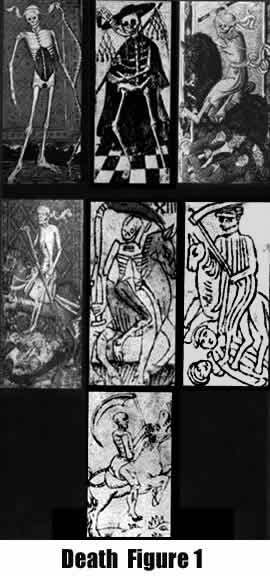 The images on the surviving DEATH cards from the 15/16th century, shown in Figure 1, are variations on the typical image of Death in Christian art: a skeleton or mummified corpse prepares to take the faithful to judgment. Five of the seven images are on horseback. Six are holding a scythe. One is holding a bow. Four of the figures have a headband, three of them flowing. Three of the images show fallen figures beneath the horses' hooves. Two of the figures are wearing a tunic or shroud.
The images on the surviving DEATH cards from the 15/16th century, shown in Figure 1, are variations on the typical image of Death in Christian art: a skeleton or mummified corpse prepares to take the faithful to judgment. Five of the seven images are on horseback. Six are holding a scythe. One is holding a bow. Four of the figures have a headband, three of them flowing. Three of the images show fallen figures beneath the horses' hooves. Two of the figures are wearing a tunic or shroud.
Death was a common image in late Medieval and Renaissance manuscript illuminations (e.g., Camille 1996). In these handmade works, the initial letters on a page are frequently "illuminated", i.e., elaborately embellished with miniature paintings. Voelkle and L'Engle (1998, pp. 270f) show paintings of death as a desiccated corpse taking a child from a France psalter ~1430-35 and Death as desiccated corpse with a mirror from a Belgian psalter ~1490-1500.
Woodcut images of Death also appear as illustrations in printed books. Hind (1935, p. 623) has a woodcut of 1486/7 showing the expulsion of Adam and Eve from the garden with a death image in the background. Andre (1996, plate 26) shows a woodcut by Durer ~1496/8 in which Death appears in the background, hiding behind a tree with an hourglass. A French psalter of 1527 (Hind 1935, p. 697) shows Death on a black horse, scythe over shoulder, crowned, bits of shroud blowing behind the head, shroud around body and blowing out at waist, riding over fallen bodies. Weinstein (1989) discusses the popular book of Savanarola sermons (1496) which had a number of illustrations using the Death theme (Figure 2).
The image of death was also familiar in church decorations. Panofsky (1939, fig 81) shows a Notre Dame bas-relief ~1220 that has death as a man on horseback, dragging off a man who appears upside down (resembling the HANGEDMAN image). Death was also common on tombs, such as the 1361 example from Naples shown by Welch (1997, p. 160). Here death is shown standing and crowned with pope/emperor underfoot.
Marshall (2000) discusses an interesting connection between the death image and the 15th century confraternities. Several painting commisioned by confraternities show Mary gathering the faithful under her cloak and protecting them from the plague. The 1464 image at Perugia contains a typical death symbol: a skeleton with bow and sheath of arrows, walking over dead bodies. The skeleton has bat wings (resembling the DEVIL image). Marshall (2000, plate 4, ~1471/2) also shows the processional banner of the Confraternity of San Benedetto dei Frustati. At the bottom of the banner, an angel drives away a blackened and skeletal death with scythe.
The Trionfi tradition
Many of the 15th and early 16th century images of Death are related to Petrarch's epic poem "I Trionfi". The connection between the early Tarot images and the artistic tradition generated by Petrarch's poem was first pointed out by Moakley (1966). The Triumph of Death is one of the six themes developed in the poem and the connection with the Death card appears to be particularly close.
But it should be clearly understood that the connection with the early Tarot images is not directly to Petrarch's words, but to the artistic tradition that developed around the poems. In fact, the artistic tradition deviated a great deal from the descriptions in Petrarch. In the case of the Triumph of Death, Petrarch's description of the image is terse: "...a woman wrapped all in blacke..." (Carnicelli 1977, p 11). The poem also mentions the emperor and pope as among the dead rulers over which Death has triumphed.
 In contrast with the brief description in the poem, the artistic tradition represents death as a dessicated corpse in a shroud on a triumphal chariot drawn by bullocks (e.g., Welch 1997). A typical image is given in Figure 3 (1487/90, San Giacomo, Bologna). Another example shows the cadaver in shroud and scythe atop a coffin pulled by bullocks and rolling over dead bodies. Gombrich (1972, plate 143) shows a similar image on a 15th century engraving from Florence. Carnicelli (1977, fig. 1) shows another example painted on the side of a 15th century chest. Aries (1985, figs. 235 and 292) shows two others.
In contrast with the brief description in the poem, the artistic tradition represents death as a dessicated corpse in a shroud on a triumphal chariot drawn by bullocks (e.g., Welch 1997). A typical image is given in Figure 3 (1487/90, San Giacomo, Bologna). Another example shows the cadaver in shroud and scythe atop a coffin pulled by bullocks and rolling over dead bodies. Gombrich (1972, plate 143) shows a similar image on a 15th century engraving from Florence. Carnicelli (1977, fig. 1) shows another example painted on the side of a 15th century chest. Aries (1985, figs. 235 and 292) shows two others.
Variations on this archetypic representation are also common. Castan (1989, p. 542) shows a 14th century woodcut with a total of 8 corpses on on the chariot, some with black hoods, one blowing a trumpet, one with a large black banner with skull and crossbones. Canicelli (1977) shows 2 images from 16th century French manuscripts that has the death figure with bow and arrow and the chariot drawn by horses (fig. 12) and the corpse as lifeless and braced by a pole atop the chariot (fig. 13). There is also a 15th century Spanish Psalter that shows the corpse with bow and arrow and wearing a papal tiara (Canicelli 1977, fig. 5). Death also appears in a 15th century image wielding a spear (Panofsky 1939, fig. 82).
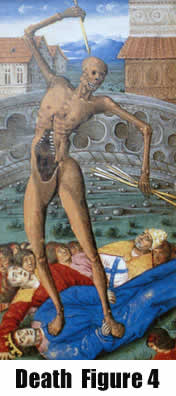 In a 1534 woodcut (Panofsky 1939, fig. 102), Death is shown triumphing over Love without the customary chariot. Death is shown as a skeleton looming over and disarming a sleeping cupid by stealing his arrows. A 1546 illumination (Voelkle and L'Engle 1998, p 277) shows Death on a throne with his victims sprawled on the floor. Another manuscript illumination ~1500 shows Death as a corpse with arrows, standing on Pope and Emperor (Figure 4). Other illuminations show death stepping out of a coffin ~1485-90 (Voelkle and L'Engle 1998, p. 274)and death with an arrow in a coffin ~1473 (Ibid., p. 275).
In a 1534 woodcut (Panofsky 1939, fig. 102), Death is shown triumphing over Love without the customary chariot. Death is shown as a skeleton looming over and disarming a sleeping cupid by stealing his arrows. A 1546 illumination (Voelkle and L'Engle 1998, p 277) shows Death on a throne with his victims sprawled on the floor. Another manuscript illumination ~1500 shows Death as a corpse with arrows, standing on Pope and Emperor (Figure 4). Other illuminations show death stepping out of a coffin ~1485-90 (Voelkle and L'Engle 1998, p. 274)and death with an arrow in a coffin ~1473 (Ibid., p. 275).
Eisenbichler and Iannucci (1990, p. 86) show an image of the Triumph of Death from 1515 with the DEVIL in the background, throwing sinners into hell. Panofsky (1939, fig. 39) also shows a 1496 woodcut with Death emerging from a coffin on one side and the Devil on the other side. As we will see below, this association of DEATH with the DEVIL is actually drawn from the Apocalyptic tradition. Thus, the synthesis of imagery from different traditions occurs in other Renaissance art, just as it does in the Tarot.
The dance of Death tradition
The Dance of Death theme typically appears as illustrations of a dancing, dessicated corpse leading off a living person. In manuscript form, the illustration will be accompanied by a brief poem addressed by the corpse to the living person and a poem constituting the person's answer. A complete work will be composed of a series of such image/poems representing different stations of life. Typically, they will begin with a poor man (FOOL?), include an artisan (BAGATTO?) and end with EMPRESS, EMPEROR, and POPE.
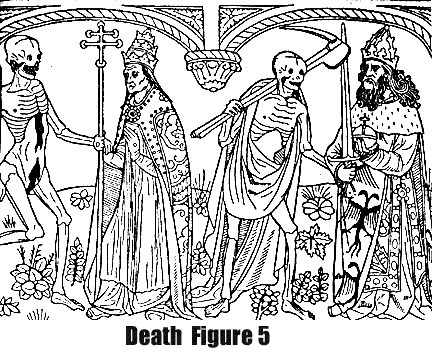 The earliest public illustration of the Dance of Death (Male 1949) is at the Cemetery of the Innocents in Paris (1424/25). The pictures no longer exist but we have 2 manuscripts from the abbey of St Victor (early 15th century) that describe "The verses of the Dance of Death as they are at the Cemetery of the Innocents". The earliest mention of the theme seems to be a 12th century poem by Helinand. By the 14th century the procession theme is clear: the human conditions marching to death. In 1485, Guyot Marchant, a Parisian printer, published his Danse Macabre with woodcut illustrations. Figure 5 shows Death leading away the POPE and the EMPEROR. In the whole work, there are 30 human conditions. Images from the dance of death began to be used by miniaturist painters in 1410 or 1415 as a dessication corpse or mummy draped in a white shroud, brandishing a dart.
The earliest public illustration of the Dance of Death (Male 1949) is at the Cemetery of the Innocents in Paris (1424/25). The pictures no longer exist but we have 2 manuscripts from the abbey of St Victor (early 15th century) that describe "The verses of the Dance of Death as they are at the Cemetery of the Innocents". The earliest mention of the theme seems to be a 12th century poem by Helinand. By the 14th century the procession theme is clear: the human conditions marching to death. In 1485, Guyot Marchant, a Parisian printer, published his Danse Macabre with woodcut illustrations. Figure 5 shows Death leading away the POPE and the EMPEROR. In the whole work, there are 30 human conditions. Images from the dance of death began to be used by miniaturist painters in 1410 or 1415 as a dessication corpse or mummy draped in a white shroud, brandishing a dart.
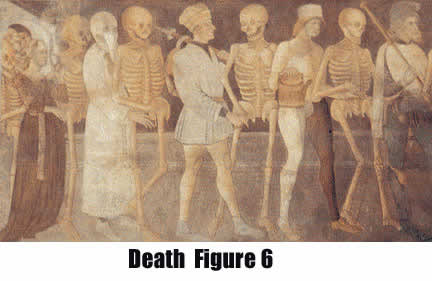
The Dance of Death became a popular topic of woodblock books that had both text and illustrations carved into wood blocks that were then inked and used to print on paper. More than a hundred copies of these woodblock books have survived. Hind (1935) provides about a dozen examples from the 15th century including illustrations from Italy, France, Germany, and England. Perhaps the finest example of these blockbooks is that of Hans Holbein the Younger ~1523-26 (Andre 1996 plates 78/79).
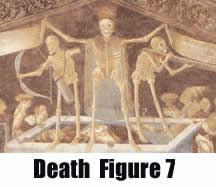
An interesting version of the Dance of Death appears as a 1485 fresco on the Oratorio of a flagellant Confraternity in Clusone (Scandella, no date). The lower portion of the fresco, shown in Figure 6, illustrates the typical scenario, including a confraternity brother in the white robe and distinctive hood of this confraternity. The upper portion of this same fresco is a Triumph of Death panel (Figure 7) with death in crown and gown standing on his throne, a tomb. At his feet in the tomb are the pope and emperor, to the left is an image of death with bow and arrows.
This fresco is interesting for two reasons. First, we see again graphic elements of the triumphal and dance traditions brought together in a single work, just as they seem to have been synthesized in the early Tarot. Second, we find another work associated with a Confraternity that contains iconology similar to the Tarot.
The Apocalyptic tradition
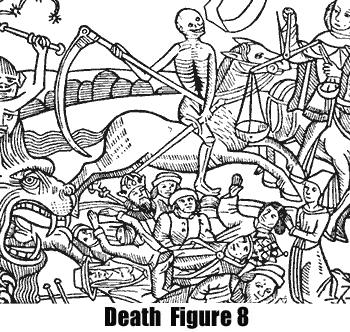 Probably the artistic tradition with the greatest influence on the early Tarot developed as illustrations of the visions in John's "Revelations", the final book of the Bible. This source for the images was suggested by Betts (1998). The Apocalyptical theme in Christian art is very old, some elements dating back to the fourth century (James 1931). Van der Meer (1978, Figure. 8) shows an early example of death on a pale horse from an illustration of ~1076 but the figure of death is not a corpse or skeleton. We will need to focus on examples from the 14th and 15th century to find the imagery in the early Tarot cards.
Probably the artistic tradition with the greatest influence on the early Tarot developed as illustrations of the visions in John's "Revelations", the final book of the Bible. This source for the images was suggested by Betts (1998). The Apocalyptical theme in Christian art is very old, some elements dating back to the fourth century (James 1931). Van der Meer (1978, Figure. 8) shows an early example of death on a pale horse from an illustration of ~1076 but the figure of death is not a corpse or skeleton. We will need to focus on examples from the 14th and 15th century to find the imagery in the early Tarot cards.
The apocalyptic imagery associated with death is taken from Revelations 6:8 , "And I saw, and behold, a pale horse: and he sat upon him, his name was death; and Hades followed with him." A typical image (Figure 8, 1478/9) shows a corpse-like figure on horseback with the various states of man lying dead beneath. Notice in Fig. 8 that the DEVIL is closely associated with the DEATH image, following behind as specified in the verse from Revelations. A similar association can be found in the Cloisters Apocalypse
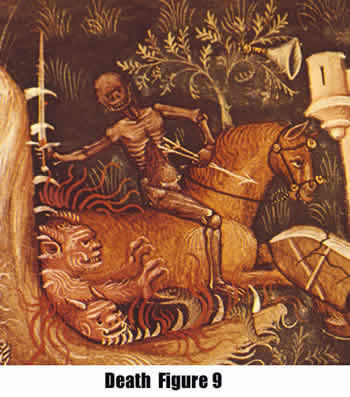
illustration of early 14th century (Deuchler 1971) which shows the DEVIL following the Death horseman. An altarpiece from Bruges 1475/9 (van der Meer 1978, fig. 168) also shows the DEVIL follow close behind the mounted Death. A famous image of Durer 1513 "The Knight, Death and the Devil" (Andre 1996, plate 39) shows Death on horseback and the Devil accompanying the Knight. The Durer 1498 woodcut of the 4 Horsemen of the Apocalypse also shows the DEVIL following Death (van der Meer 1978, fig. 189).
An even more fascinating combination of images in found in a Flemish Apocalypse of 1400 (Figure 9). Here the rider is armed with arrows and is associated with images of the DEVIL to one side and a TOWER with a falling top to the right. Although it is not visible in the figure, this page also shows STARS, MOON, and the SUN in the sky overhead.
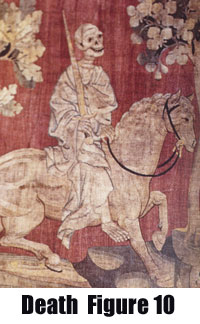
The image of Death as the Apocalyptic rider on a pale horse was a familiar symbol in the 14th to 16th century. It can be found on tapestry (Figure 10, ~1373/81) as discussed by Grubb (1997). It also can be found painted on wooden panels, e.g., Naples ~1330/40 (van der Meer 1978, p. 134) and stained glass ~1550 (van der Meer 1978, p. 204). But the most common and accessible images were in woodblock illustrations. Figure 11 shows a typical figure on horseback with bow and arrow and Figure 12 shows a walking Death with scythe. Both Figures come from the same woodcut ~1463.

A particularly interesting example is found at the Pisa Camposanto ~1330 (Paoletti and Radke 1997). One wall of this indoor burial ground shows the Triumph of Death on one large panel and the Last Judgment with apocalyptic theme in the panel next to it. The triumph images are dispersed angels with trumpets and devils and graves, no skeleton on a chariot, instead Death is flying through air in shroud and swinging the scythe (as in Figure 12). Once again we see themes from related artistic traditionsbeing combined to illustrate the death theme.

Iconological analysis
It appears that every detail of the early Tarot images falls within the range of religious imagery available when the Tarot was designed. The figures of Death on horseback can be explained within the Apocalyptic artistic tradition. Symbols of Death with scythe or bow and arrow are common. Images with flowing shrouds and bits of bandage blowing were available. The images in the Triumphal and Apocalyptic traditions both show various states of man being trampled. The Tarot image appears to synthesize elements from the three traditions, but we have seen a number of other contemporary images which also utilized this synthetic quality. There doesn't appear to be any element of the imagery which was not readily interpretable by the 15th century viewer within the Christian artistic and symbolic imagery of the times.
There is also a critically important point that follows from the study of the iconology of the early Tarot images of Death. The image of the corpse/skeleton and scythe is NOT an ancient symbol for Death. Lessing (1879) demonstrates that the Greek and Roman cultures used the image of a young man, often winged, inverting and extinguishing a torch. Additional iconology involved a butterfly to represent the soul of the deceased and a laurel wreath to represent the victory of a noble life and death. This imagery continued to be used into the Christian era.
In the few instances where dancing skeletons are found in Roman times, they are ancillary decorations that elicit a feeling of "make merry while you may" (Clark 1950). They are never the primary figure and never represent death itself. The skull with mandible and crossed femurs is often found in old tombs due to the reuse of limited grave space. When the old graves were reused, the skeletons were discarded and the skull and crossbones were retained as decorative features. But here the skull and crossbones represents the unknown deceased, not death itself.
The three artistic traditions that we have examined are older than the corpse/skeleton symbol. The Dance of Death is probably based on poems that date back to the 11th century. But the images of death that accompany the poems begin in the 15th century (Clark 1950). The illustrations of the Triumph of Death are from the 15th century. The Apocalyptic illustrations are found throughout the medieval period, but the early illustrations of the 4 horsemen show humans or angels, never skeletons. The earliest use of the skeleton image is from the latter half of the 14th century.
The lack of any examples of the corpse/skeleton symbol prior to ~1360 may prove to be a serious embarassment to any theory of Tarot origins that postulates an earlier date. In this case, the problem cannot be dismissed by saying that earlier decks have been lost. The corpse/skeleton symbol does not exist in more durable forms such as church decorations, tomb inscriptions, or illustrated manuscripts. At the very least, it seems safe to conclude that the card-player would not have been familiar with this death symbol until the late 14th or early 15th century, thus confirming all of the other documentary evidence for this period as the earliest possible date for the Tarot.
In a previous study I offered the tentative hypothesis that the origins of the Tarot might be linked to the Confraternities. In the light of future research, it may or may not be significant that several of the images of Death cited here were commissioned by Confraternities. But it remains that a major function of the confraternities was to support its members as death approached, to bury the dead, and to pray for their souls in order to shorten their period of atonement in Purgatory (Banker 1988).
The previous study also offered the hypothesis that the origins of Tarot might also be linked to the Franciscans who fostered the early Confraternities. In this light it is interesting to see the position that the Franciscan Friar plays in the 15th century Dances of Death. Clark (1950) points out that some of the poems appears to borrow lines from the "Little Flowers of St. Francis". There is a clear distinction between the way the friar is treated, compared to secular clergy. In many instances, the friar appears to be preaching to the corpse rather than vice-versa. In conclusion, Clark (1950) states, "It is evident that the Mendicant Orders played a notable part in the diffusion, perhaps also in the creation, of the Dance of Death."
Interpretation
It remains to reconstruct what the symbol of death might have conveyed to the 15th century card-player. Such a reconstruction may be difficult in our own times. We live in an age of optimism in which, as an result of our own actions and advances in biological and medical sciences, we can influence the length of our life and our state of health. We can view Death as a challenge, it will inevitably win, but we have an arsenal of weapons to put up a good fight!
Things must have looked rather different in the 15th century. Death would been seen less as something to fight and more as something to be accepted (Aries 1974). One-third of newborns didn't make it to their second birthday (Carmichael 1989) and in addition to periodic outbreaks of bubonic plague, adults were frequently dehabilitated by diseases such as small pox, gout, and tuberculosis. They would have viewed Death as less controllable than we do. In an age of faith, they would also have viewed the ravages of Death as self-recriminations. What mother could regard the death of her infant without feelings of deep guilt.
As a result of their own personal feelings of helplessness in the face of disease and death, there was a fascination and infatuation with death in 15th century Italy (Tetel et al 1989) and it became a popular form of devotion (Tenenti 1957). Binski (1996) calls it "Death Culture" involving ritual, images, literature, monumental ornaments, prayers for the dead, belief in purgatory, the criticality of indulgences, etc. Meiss (1951) shows how the intimate consciousness of death, e.g., in the Black Death, influenced life, art, religion, and society. A Savanarola sermon (Weinstein 1989) recommended that one keep an image of death in a place where it could be viewed frequently during the day. In that way, one could evaluate one's minute-to-minute actions in the light of their ultimate ramifications in the afterlife!
In all of the variant orderings of the individual trumps that occurred during the 15th century, Death always is assigned the number 13, the unlucky number. Based on a superstition that still endures today, the card-player would have viewed Death as an appropriate symbol of bad luck -- indeed the ultimate bad luck. With Death as an unavoidable fact of everyday life, it seems reasonable to assume that the number 13 and the symbol of Death would have been interpreted, at least superficially, as misfortune.
In the previous study {insert link to Catharism and the Tarot} I also laid out the evidence for the apocalyptic belief that the end of the world was near (e.g., McGinn 1979). Largely through the preaching of the Spiritual Franciscans, the card-player was likely to be convinced that the corruption in the Church and social injustice were clear evidence for the end of the world. Thus, once again, the symbol of Death would have been associated with theological and escatalogical issues that do not concern the modern viewer.
In a very real sense, Death was the dividing line between the natural and supernatural. Death was the ultimate proof of the supernatural, not for the theologian but for the ordinary believer. With no theory of reincarnation, injustice made no sense without Death and an afterlife as the final arbiter. Likewise, pain, depression, and frustration made no sense. Straw (2000) points out the importance of death and judgement in Christianity, the religion of martyrs. Given the impossibility of living a life without sin, a noble death held the only real hope. At the moment of death, social and political order focused down to the individual and their personal biography and endurance. This was the attitude toward death as the critical transition point preached by the Mendicant orders in the 14/15th century (Aries 1974) and is very similar to the 'endura' preached in the Cathar heresy.
At a deeper level, for the mystic or magus, the Death symbol would have called to mind the Mystical Death, leading to rebirth in the spirit. The concept would have been familiar to the religious mystic through the numerous writings produced during the period 1200-1350 , called by McGinn (1998) the "Flowering of Mysticism". The concept would have been familiar to the esoteric magus through the alchemical manuscripts which were beginning to become available as the Tarot was designed (Jung 1944).



